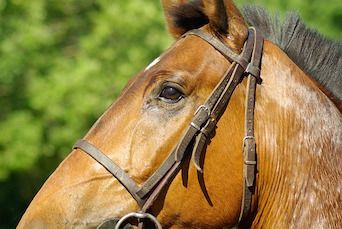WVC 2017: Pain Control for the Aging Horse
At the 2017 Western Veterinary Conference in Las Vegas, Lori Bidwell, DVM, DACVA, CVA, CVTP, presented an update on analgesia in geriatric horses.

Medical advances mean that many horses are living longer today, sometimes up to 35 years. As they age, horses may be prone to developing painful disease states. It is important to provide therapeutic analgesia to decrease discomfort and enhance quality of life in these animals.
At the 2017 Western Veterinary Conference in Las Vegas, Lori Bidwell, DVM, DACVA, CVA, CVTP, presented an update on analgesia in geriatric horses. “Geriatric” is defined as having achieved 75% of the average lifespan. The average lifespan of horses is 25 years, so horses are considered geriatric once they reach age 18. It is important to consider that cold bloods (draft breeds) generally age more quickly and have a shorter lifespan overall.
Old Age Is a Disease
Despite the notion that “old age is not a disease,” aging is a progressive physiologic disease that may be hastened by a number of factors, noted Dr. Bidwell, who is the owner and co-founder of East-West Equine Sports Medicine in Lexington, Kentucky. Concurrent disease, stress, chronic pain, malnutrition, lack of exercise, and the environment all contribute to the aging process and may increase the rate of deterioration.
The physiologic systems most likely to be impacted by the aging process include the cardiovascular, musculoskeletal, nervous, pulmonary, renal, and hepatic systems. As horses age, they lose both muscle mass and body water; these changes decrease the metabolic rate and affect the response to various drugs. In particular, older horses will have fewer circulating serum proteins, so drugs that are protein bound may have a higher circulating concentration.
A significant concern for the older horse is the risk for dementia. Opiates have been associated with signs of dementia in horses, so caution should be used with that class of drugs. Additionally, any drugs that cause vasoconstriction, such as atropine, may increase the dementia risk due to decreased blood flow to the brain.
Neuropathic pain is a malfunction of the nervous system whereby the nerve itself is the source of the pain instead of merely transmitting a pain signal. This type of pain may be seen in horses with chronic arthritis and chronic laminitis. Gabapentin (2.5 to 10 mg/kg PO q12h) may be used to treat neuropathic pain. The United States Equine Federation (USEF) has a 14-day withholding period for gabapentin.
Pharmacologic Pain Management
Nonsteroidal anti-inflammatory drugs are the gold standard for treating pain in the geriatric horse, but it is important to monitor bloodwork and quality of life. Additional options for pain management include opiates, gabapentin, lidocaine, and herbal supplements. Dr. Bidwell has experience using aspirin 80 mg + omega-3 fatty acids, as well as flunixin, phenylbutazone, and firocoxib.
Multiple opiates may be used in the aging horse but, as noted earlier, it is important to monitor patients for dementia. Morphine is an inexpensive mu receptor that may be injected in many locations. Butorphanol may be given subcutaneously and has a duration of action of 2 to 5 hours; this method can be effective for abdominal pain. Dr. Bidwell often gives butorphanol with alpha-2 drugs to minimize excitation and enhance analgesia.
Buprenorphine is a partial mu agonist and a kappa agonist. Sustained-release buprenorphine is a compounded version of the drug that is given subcutaneously and lasts 2 hours. Methadone is a class II controlled substance available with multiple routes of administration. This mu receptor agonist is available as fast-dissolve tablets for oral administration and an injectable formula. Fentanyl is a short-acting pure mu agonist available in injectable, patch, and gel formulations.
When considering other pain control options, Dr. Bidwell recommends evaluating lidocaine, which can be used topically, transdermally, subcutaneously, intramuscularly, or intravenously. Lidoderm patches have 700 mg lidocaine in a 10×14—cm patch. About 3% (21 mg) of the patch is absorbed locally rather than systemically, and the patch may be cut to the shape of a wound. Analgesia will begin about 2 hours after placement and will wane after 11 hours. Clients may be taught to apply or exchange pat ches. Due to the high drug concen- tration, great care should be used to prevent accidental oral ingestion by children or dogs.
Alternative Pain Control Measures
In addition to traditional analgesics, other compounds or medications may be used to support comfort in the aging horse. Dr. Bidwell recommends becoming familiar with various supplements, although she noted, “I am amazed by how often a new compound comes out.”
Anti-anxiety medications may be used to help ease discomfort. Many of these may be given as feed supplements. Despite having no analgesic properties of its own, acepromazine may be given to allow other medications to be more effective.
Sarapin is a P-blocker compound made from the Sarraceniaceae family (pitcher plant) that has local anesthetic and anti-inflammatory effects. The salts of the plant are placed in a sterile solution for intravenous, subcutaneous, intramuscular, or joint injections. In humans, this compound may be used for neuropathic pain; due to its plant origin, it is sometimes referred to as a “veggie block.”
A variety of herbal remedies are available as well. Dr. Bidwell recommends researching the source of each compound, as some may be less efficacious or may be from untrustworthy sources. Dr. Bidwell routinely uses Jing Tang Herbal Body Sore to treat chronic discomfort, but it is important to understand the Fédération Equestre Internationale (FEI) and USEF regulations related to herbal combination therapy.
Traumeel and Zeel are combinations of arnica, echinacea, and deadly nightshade given for their analgesic and anti-inflammatory properties. These compounds are legal for use within FEI and USEF regulations.
Resveratrol is a phenol compound designed to reduce gene expression of inflammatory enzymes. Equithrive is an equine variation of Resverasyn, a microencapsulated form of resveratrol.
Acupuncture may be used to stimulate A delta, A beta, and C fibers peripherally, signaling molecules to assist analgesia. Electroacupunture will cause a release of opioid peptides, but it is dose dependent.
Conclusion
It is always important to assess the goals and capabilities of the client when choosing a therapeutic protocol for managing pain. Appropriate setting of expectations will be rewarding for all who are caring for aging horses.
Dr. Landis-Hanna, a 2002 graduate of Auburn University, has practiced small animal, exotic, shelter, and relief medicine. She was a medical director at VCA for 7 years and served as director of veterinary medicine for Voyce. She is currently the senior manager of veterinary outreach for PetSmart Charities.

Podcast CE: A Surgeon’s Perspective on Current Trends for the Management of Osteoarthritis, Part 1
May 17th 2024David L. Dycus, DVM, MS, CCRP, DACVS joins Adam Christman, DVM, MBA, to discuss a proactive approach to the diagnosis of osteoarthritis and the best tools for general practice.
Listen